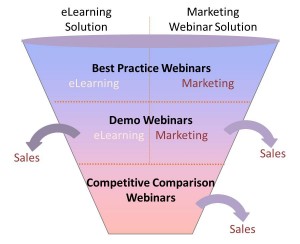Webinar content is as important as demographics when qualifying leads. As discussed in my previous blog, webinars are a tactic – it’s the content that determines where the webinar falls in the B2B marketing lead gen funnel. The webinar content will therefore tell you what stage the buyer is in and what they are interest in. It will dictate which webinar registrants are simply contact acquisitions and which ones are truly sales ready. Knowing the difference will improve the quality of leads you send to sales and build the sales team’s trust in your marketing leads.
For example, thought leadership or best practice webinar content types are great for contact acquisition, but do not generate sales-ready leads as these content types do not indicate shopping behavior. Attendance at a webinar product demo or competitive comparison review however would definitely indicate shopping behavior and readiness for sales follow up.
Not only does content type indicate buying stage but it can tell you a lot more about the individual’s interests and needs. Using webinar content to determine this information is especially helpful if your product offers multiple solutions or you target several different audiences.
I’ll use my own webinar program to illustrate what I mean… 
The product I market offers multiple solutions, two of which are our main focus (eLearning and marketing webinars). I use a monthly best practice solution webinar focused on each solution at the top of my funnel. I spend most of my budget driving registration to these webinars and I do NOT send these registrations to sales. I consider them contact acquisition. However, these webinars are super valuable to me because they tell me one extremely important thing about the folks that register: they are exactly the people I need to reach about my product. If contacts attend a webinar on eLearning best practices, for example, that tells me that they are either interested in starting an eLearning program or already have one in place.
Now, if I were to hold a webinar about general web conferencing that encompassed a generic overview of best practices for all the possible solutions web conferencing offers, I would not be any closer to understanding how the webinar registrants use web conferencing or what solution they are interested in. This is a false start and I would have nowhere to go with these contacts from this point. Additionally, my registrations would be low because, in today’s digital age, no one has time to weed through irrelevant information to get at what they need.
However, since I’ve used the content of my webinars to determine solution of interest (regardless of title I might add – because titles do not tell the entire story), I ask each separate group to attend a demo of my product based on the solution they showed interest in. The demo webinars are geared toward each specific solution so that we are only showing off the product as it relates to the audience’s specific interest. If a contact attends one of these webinars we understand that they are at least interested in seeing what our product has to offer and may be shopping. I definitely send these leads to sales, and sales knows exactly how to craft the conversation because the content of the webinar tells them the solution of interest.
After this step we then ask registrants from the upper-funnel webinars to attend a competitive comparison webinar. If the contacts sign up for this webinar, the comparative nature of the content tells me they are most definitely shopping and comparing their options. I happily send these leads to sales with confidence.
It’s all about relevancy and delivering what individuals need at the right time.
Can you think of ways to use webinar content to qualify your leads and send valuable information to sales at the same time?
Next week I’ll talk about how to use behavior to further qualify leads.